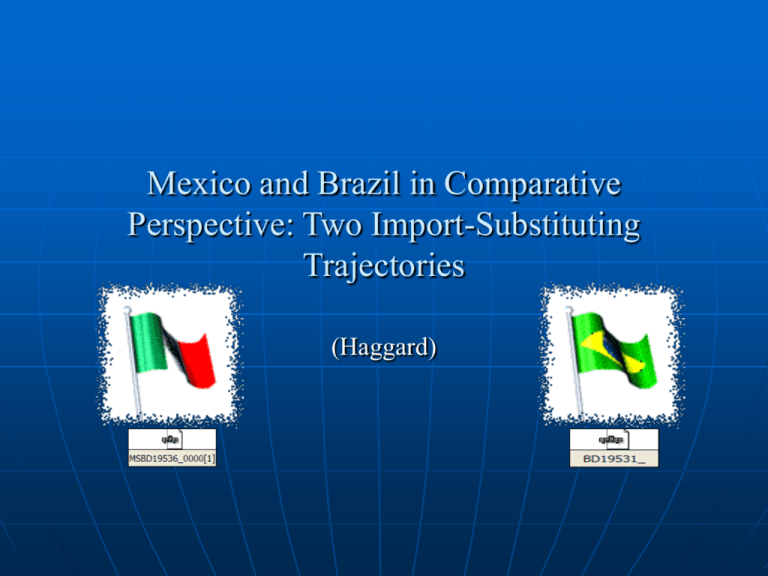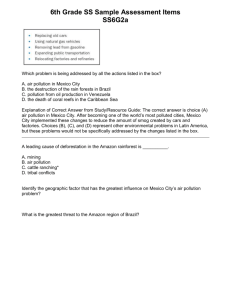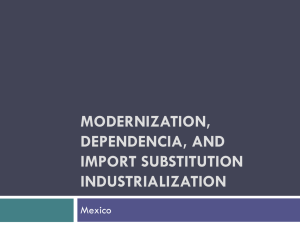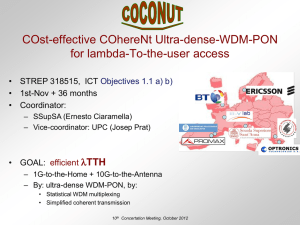Mexico and Brazil in Comparative Perspective: Two Import
advertisement

Mexico and Brazil in Comparative Perspective: Two Import-Substituting Trajectories (Haggard) WHY ISI? 30s & 40s Twin Shocks: Elites response = expansion 50s Secondary ISI: Economic Motivationsexternal shocks, size, resource endowment, balance of payments problems, FDI & borrowing Social/Political Motivations: Pressure of urban political sectors, Business support, manipulation of ISI for political gains, intellectual rationale. 70s Debt Led ISI: supplement ISI with non traditional exports. Euromarket credit, FDI & oil boom. The Primary-Product Growth Phase Exporters of Primary Goods: coffee, many crops Agro Export Sector: Coroneis – Cacique 30s: Social Adjustment - Mexican Revolution Difference with Taiwan and Korea: political independence, diversified economies and decentralized politics. External Shocks, Political Consolidation and the Origins of ISI BRAZIL Twin Shocks: Policy experimentation by Fed. Deficits, expansive monetary policy, trade and exchange control. Political Motivations: Authoritarian Government, bourgeoisie ascendance and coffee planters decline MEXICO Depression: end of orthodoxy. Expanionary monetary and fiscal policies, Political Consolidation (post revolution), reconstruction of financial system, centralization of the tax system Cardenas 20s: Populist government. Nationalist development > Strong Unionism Secondary ISI Increased role of Government Assumption: Due to comparative adv. in agriculture, protectionist measures for industrialization. Coalition Factors: Correlation of forces: support for technocrats Brazil: cross-class electoral alliance Mexico: Organizational efforts of a dominant party Towards Secondary ISI BRAZIL Initial Liberal modifications 50s Industrialization support: emergence of a labor, professional, managerial and bureaucratic middle class. Kubitschek Regime: expansion of state role Need for FDI and preferencial exchange rates MEXICO Reversal of Cardenismo: greater support for industry Containment of labor demands Creation of Central Bank, anticipatory devaluation Orthodox Macroeconomic policies – Activist industrial policies The Third Path of ISI From mid 60s and early 70s to the debt crisis 80s New Balance of payments constraints: oil shocks and inherent vulnerabilities of the model. Response: expansion of non traditional exports – contradiction with macroeconomic policies Political pressures to maintain high economic growth introduction to democracy; opposition forces within PRI 80s collapse of external financing: real devaluations, wage cuts State response to shocks – function of political institutions Constrains of new social groups after democratization over economic policy Mexico: regional leader on outward looking policies Debt Led Growth and Export Promotion BRAZIL Replacement of FDI with foreign borrowing 60s military’s economic strategy: political repression 67 Need of support from domestic private sector and middle class. 68-73 Brazilian Miracle: outward looking First Oil Shock: non heterodox approach MEXICO Response to social unrest: redistributive measures, education and welfare incentives, + control over FDI Response to ISI vulnerabilities: incentive for non traditional exports Contradition with continued support for capital-intensive industries = Increased Borrowing Oil Boom: expansion of ISI & social expenditures 1982: Mexico announces it can’t pay its debt Big Business and the Politics of Economic Reform: Confidence and Concertation in Brazil and Mexico (Schneider) Economic Reform Variations Similar Development Strategies Argument: variations depended on relations between business & government A- Deeper financial crisis in Mexico B- Concertation sped reform implementations Investment Crisis and Radical Reform Investment Crisis: contraction of capital flows from abroad, public savings and private investment Reform initiatives: Investment Crisis vs. Political Change Mexico: falling oil prices, 13% public deficit = borrowing greater capital flight, need to restore business confidence CONCERTATION Mexico (CMHN) > Brazil (ISID) Stabilization through Concertation MEXICO 87 Pacto de Solaridad Economico: coordinated expectations 87 Stock market crash 95 Crisis: end of pacto BRAZIL Social Pacts: could not set an income policy Negotiation in Trade Liberalization MEXICO COECE influence on NAFTA negotiations Benefits: Info flow, government BRAZIL Concertation vs. Consultation: never institutionalized Radical market oriented reform: IEDI creation Sectoral Arrangements: adjustment to Intl. competition Concertation Auto Industry success Benefits and sources of Concertation BENEFITS Concertation is not indispensable Concertation is preferable Flexible nature Vulnerable nature COSTS Greater rigidity on the implementation of reform Delay on implementation Further Implications Business Elites – State Elites: Exit & Voice State dependence in Private Investment Business influence: function of degree they can limit government policies State influence: sets the Agenda State weakness: exit Business Weakness: ambiguity for neoliberal reform “State actors trade some autonomy for greater capacity” Questions 1)- In which ways does ambiguity for the neoliberal project work against businesses? 2)- Why do you think countries with small markets and more limited resource endowments (Uruguay and Costa Rica) adopted ISI? 3) - Do you think concertation has a real effect on economic policy or is it a tool for the national government to manipulate business behavior?






